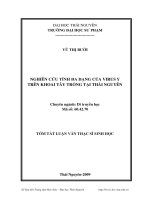virus powerpoint templates - beautiful
Bạn đang xem bản rút gọn của tài liệu. Xem và tải ngay bản đầy đủ của tài liệu tại đây (460.08 KB, 15 trang )
HERPES SIMPLEX VIRUS
Characteristics of HSV
•
DNA double stranded virus, linear
•
125-250 Kb long, relatively big
•
Enveloped
•
Virion size 200 nm, relatively big
•
9 HSVs, Ex. Varicella, EBV, CMV
•
Diseases: Chickenbox, Mononucleosis,
Hepatitis, Encephalitis
•
Recurrent eye, mouth and genital lesions
Chickenpox, Varicella
Zoster
Herpes Virus and Common Diseases
•
Everybody knows chickenpox and likely you experienced the disease
as a child, can be dangerous when exposed to it in adulthood
•
Another common ailment is lip and mouth “cold sores”
•
Genital Herpes lesions caused by HSV, sexually transmitted
•
HSV-1 cold sores (mild but annoying diseases)
•
HSV-2 genital herpes
•
Varicella zoster: chickenpox
•
However the Herpes family is huge, over 100 members
HSV-1 Cold sore HSV-2 Genital Herpes
HSV Establishes Latent Infections
•
Once infection has taken place HSV can remain dormant
for months, years, lifetime
•
Cell types that HSV can infect and remain dormant
–
Neurons, B-cells and T-cells
•
Examples:
–
Shingles which can appear years after first chickepox infection
(caused by varicella zoster, causes both chickenpox and shingles)
–
Genital Herpes outbreaks
Herpes (1-2) Simplex Virus Genome
HSV Capsid
•
Enclosed in an envelope
•
Capsid has icosahedral structure
•
Capsid is bilayered
•
Constructed from 6 proteins
–
VP5 is the main one
•
Envelope contains at least 10 different glycoproteins gB-gM
•
Envelope also contains non-glycosylated proteins
HSV Entry Into Host Occurs Via Heparan Sulfate Proteoglycans
•
gB and gC bind to host glycoproteins with heparan sulfate moieties (repeating
dissacharide: glucoronic and n-acetyl glucosamine)
•
Following gB and gC is gD which binds to nectin1D
•
OR HVEM (herpes virus entry mediator)
•
Fusion occurs between viral envelope and host membrane
•
Nucleocapsid is released into cytosol OR in acidified endosomes
•
Transport to nuclear envelope occurs via µT and capsid interaction
•
DNA is released into nucleus
•
Capsid disintegrates
/>
Genome Expression in Nucleus
•
Viral DNA is circularized once inside nucleus
•
Viral DNA is localized in regions referred to as ND10
(nuclear domain 10)
•
Viral genes transcribed by cellular RNA Poly II
•
Gene expression divided into 4 groups
•
Group α occurs within hours of viral infection (these genes
also referred to as “immediate early genes”)
∀
β genes (early genes) transcription occurs 4-8 hrs past
infection
β genes involved with viral DNA replication
∀
γ1 and γ2 (late genes) are the bulk of viral genes
Tegument Proteins
∀
α-TIF (a-trans-inducing factor) interacts w/Oct-1 and HCF-1 (both
cellular proteins)
•
Significantly increases transcription of viral α genes
•
Vhs (virion host shutoff) protein
–
This protein interacts with cellular proteins
–
Mediates degradation of both cellular and viral mRNAs
–
Degradation rate of viral is much lower compared to cellular,
therefore they dominate
β Genes Set Stage For Viral DNA Replication
•
HSV makes its own DNA polymerase
•
3 Replication Origins (2 oriS, oriL)
•
Viral DNA is circularized
•
U
L
9 binds ori S and unwind dsDNA, ICP8 helps in
stabilizing ss DNA
•
U
L
5, U
L
8 and U
L
52 (referred to as DNA helicase-primase
complex) bind ss DNA and synthesize RNA primers
•
U
L
30 (DNA polymerase) replicates DNA
•
U
L
42 significantly enhances processivity
Viral Genes Block Immune Response
•
Out of 84 genes only 37 involved in replication
•
Some of the remainder involved in blocking immune
response against virus
•
Vhs and ICP27 block interferon effects by degrading cellular
mRNAs
•
ICP47 binds transporter proteins that aid antigen presentation
–
Self and viral peptides are constantly being presented thru MHC I
and provoke immune responses when appropriate
–
ICP47 prevents transport of viral peptides on surface of cell
⇒ no viral antigen presentation which means no immune response
Viral Genes Block Immune Response
HSV Latency
•
Latency is typical in HSVs
•
In case of infected neurons retrograde transport occurs and virus
gains access to nucleus and can stay dormant for years
•
Latency is attributed to
–
Limited amount of VP16 (viral tegument protein) enters nucleus
⇒ No VP16 no α gene expression
•
Neurons contain Luman and Zhangfei transcription factors
–
These transcription factors bind HCF-1 and inhibit formation of transcription
complex Oct-1/HCF-1/VP16
•
Only viral transcription that takes place is LAT’s (Latency
associated transcripts)
Envelopment and Egress: 3 Possible Routes
Envelopment and Egress: 3 Possible Routes
•
HSV nucleocapsids are assembled in the nucleus
•
It is thought that nuclear membrane is the source of the envelope
•
Budding occurs from inner nuclear membrane to nuclear lumen
•
Three theories are currently used to describe the transport from
nucleus to outside the cell
•
One theory predicts that virions exit nucleus without envelope thru
nuclear pores (they enlarge to accommodate exit)
They gain envelops in the cytosol by mixing with fragmented
golgi fragments







